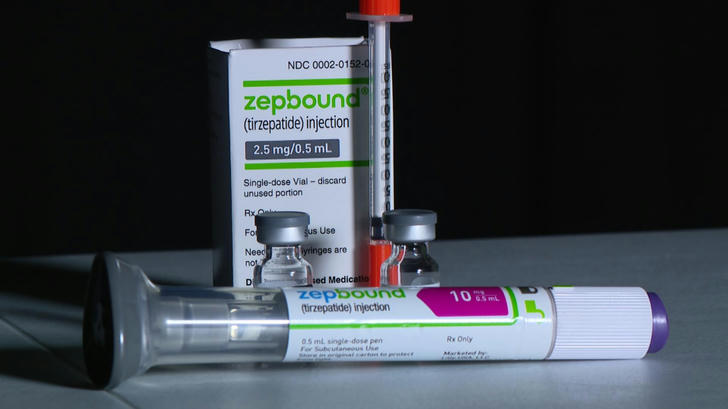Zepbound (Tirzepatide injection): Proven to effectively and affordably help lose weight and maintain weight
As the first FDA-approved dual GIP/GLP-1 receptor agonist, Zepbound has not only proven its significant weight loss effect through rigorous clinical trials—average weight loss of more than 20%, and long-lasting and stable results—but also has become a weight management option that is both effective and economical due to its innovative pricing strategy and insurance coverage plan. This article will analyze Zepbound's mechanism of action, efficacy data, and the drug's multi-level cost support plan.

Zepbound: A breakthrough dual-target weight loss therapy
📍Zepbound (Tirzepatide):
Zepbound is a revolutionary weight loss drug that was approved by the U.S. FDA for chronic weight management in 2023. As the first and currently the only dual agonist that simultaneously activates GIP (glucose-dependent insulinotropic polypeptide) and GLP-1 (glucagon-like peptide-1) receptors, Zepbound represents an important breakthrough in the field of obesity drug treatment.
📍The drug is suitable for two groups of adults:
One is adults with obesity (BMI ≥ 30);
The other is overweight adults (BMI ≥ 27) with at least one weight-related comorbidity (such as hypertension, type 2 diabetes or high cholesterol).
📍epbound's administration method:
Subcutaneous injection once a week, the dosage regimen needs to be gradually increased within 4-20 weeks, eventually reaching a target maintenance dose of 5 mg, 10 mg or 15 mg per week. This drug acts on the appetite regulation center of the brain and the digestive system by simulating two hormones naturally produced in the intestines, effectively reducing appetite, increasing satiety, and improving blood sugar control.
Efficacy data of excellent weight loss effect
📍Weight loss effect:
Lilly has verified the excellent efficacy of Zepbound through a series of rigorous clinical trials, and published the results of the SURMOUNT trial in the New England Journal of Medicine in May 2025. This randomized controlled study included 751 American patients with obesity or overweight and at least one weight-related health problem (excluding diabetes), and divided them into two groups: one group received Zepbound treatment and the other group received Novo Nordisk's Wegovy treatment.
After 72 weeks of treatment, the results showed:
| Evaluation Metric | Zepbound Group | Wegovy Group | Relative Advantage |
|---|---|---|---|
| Average Weight Loss | 20.2% (~22.8kg) | 13.7% (~15kg) | 47% higher |
| Waist Circumference Reduction | 18.4cm | 13.0cm | 41.5% higher |
| Proportion Achieving ≥25% Weight Loss | 31% | 16% | 93.75% higher |
| Discontinuation Due to Side Effects | 6% | 8% | 25% lower |
🚨Gender differences were also observed in the study - the weight loss rate of men in both groups was about 6% lower than that of women. As weight was reduced, multiple health indicators (including blood pressure, blood lipids and blood sugar levels) of both groups of patients were significantly improved.
📍Long-term maintenance effect:
Real-world data long-term follow-up studies show that patients who completed 72 weeks of treatment and continued to use maintenance doses under the guidance of doctors were able to maintain more than 80% of their weight loss results for more than one year. This finding is of great significance for the long-term management of obesity, a chronic disease.
(Although tepoxetine is better in weight loss, both drugs are important for the treatment of obesity)
Affordable price strategies: Expanding access to medicines
📍Basic pricing advantage:
The standard price of the Zepbound injection pen is $1,059.87/month (excluding insurance), which is about 20% lower than Novo Nordisk's Wegovy ($1,349/month), which can save patients nearly $3,500 per year.
Innovative options for small bottles:
• 2.5mg dose: $349/month (about 67% reduction)
• 5mg, 7.5mg and 10mg doses: $499/month (about 53% reduction)
Small bottles require patients to fill syringes by themselves, which increases the complexity of use, but greatly reduces the financial burden and becomes a viable option for uninsured patients.
📍Savings plan:
Lilly has launched the "Zepbound Savings Plan", with eligible commercial insurance patients paying as little as $25 per month. Even patients without insurance coverage can get discounts of up to $563 through this plan.
📍Commercial insurance coverage:
Many commercial insurance plans have included Zepbound in their prescription drug lists. Patients should contact their insurance company to learn if Zepbound is covered and for specific copay, deductible, or coinsurance details.
📍Patient Assistance Programs:
For patients who are uninsured or experiencing financial hardship, Lilly may also offer patient assistance programs to help them get the medications they need.
📍Healthcare Provider Consultations:
Physicians and pharmacy staff can provide guidance on insurance coverage and payment options and help patients understand if there are other resources available.
How to Start Zepbound Treatment
If you are considering Zepbound for weight management, here are the steps you should take:
• Talk to your doctor:
Discuss weight management goals and health history, assess your suitability for Zepbound, and consider your other health conditions and medications.
• Understand your medication:
Carefully read Zepbound's prescribing information and patient medication guide to understand its potential benefits, risks, and possible side effects.
• Develop a treatment plan:
Includes Zepbound's starting dose, dose adjustment schedule, and how to combine it with a healthy diet and increased physical activity.
• Learn how to inject:
Learn how to inject subcutaneously with the prefilled pen.
• Follow up regularly:
Monitor weight loss progress, side effects, and other health indicators so your doctor can adjust your treatment as needed.
